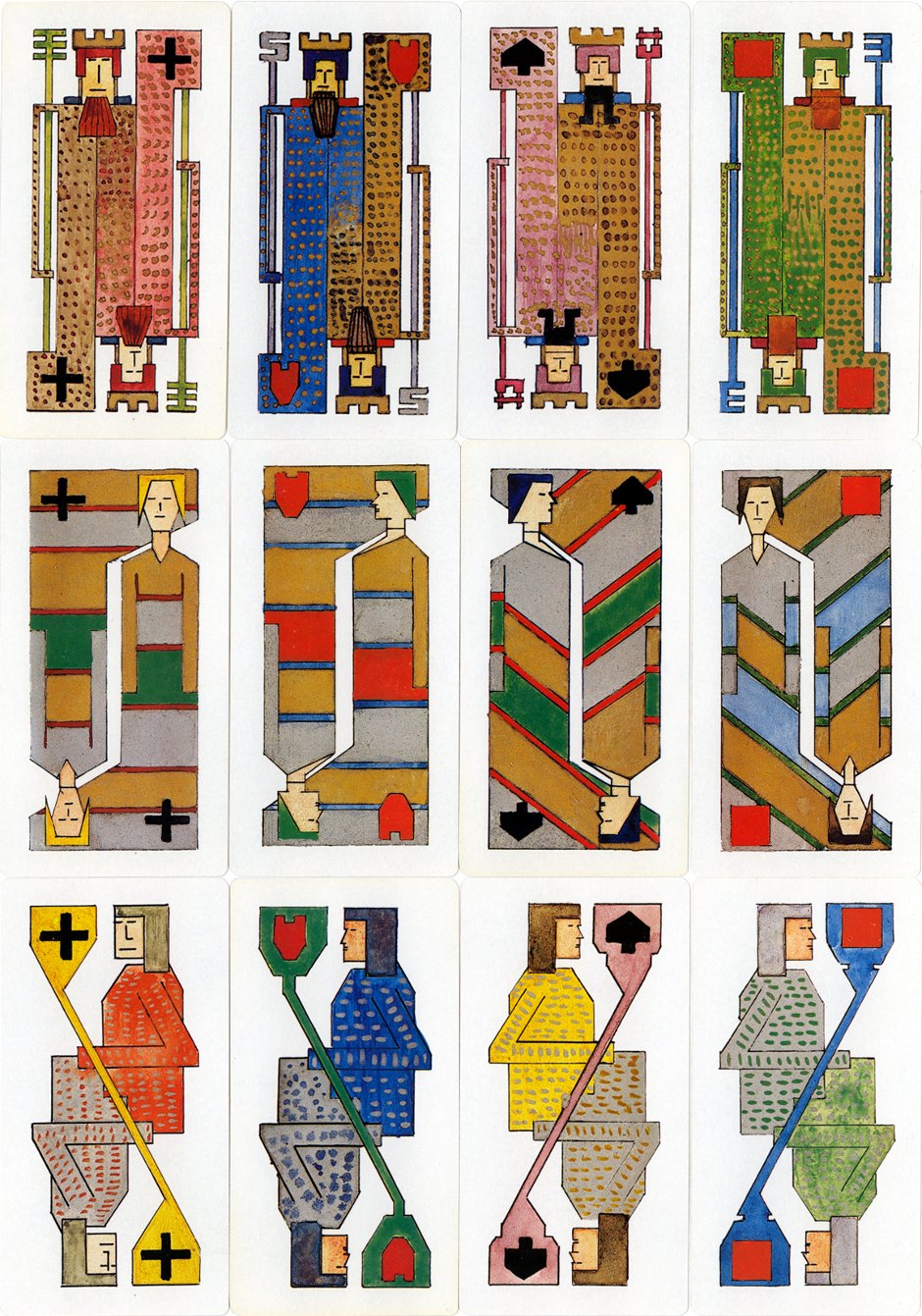Arnold Schönberg
In around 1909 he created three sets of playing cards. His inventiveness was driven by a passion for rules, order and numbers.
Playing Cards created by Arnold Schönberg
"Self-expression is the thing! Direct self-expression! But not expressing one's taste, one's education or one's intellect, one's knowledge or one's skills. None of these acquired qualities. Rather the innate, instinctive qualities. And the quest for form - the conscious quest - is bound to involve some kind of mathematics, or geometry, the golden section and so on..." - Extract from a letter from Schönberg to Kandinsky, 24.1.1911.
Arnold Schönberg's (1874-1951) creativity was not limited to music. He practised several extra-musical pursuits, producing at least 250 paintings, toys, games, chess sets and playing cards for his own use. He even did his own bookbinding. In around 1909 he created three sets of playing cards. One set used grotesque imagery and visual puns from his caricatures and doodles, with the suit symbols integrated into the designs (see image→). Another set (shown below) is more severe and geometric, almost digital. His inventiveness was driven by a passion for rules, order and numbers, and his cards also reveal his capacity for highly personal expression. The elongated cards are divided into four suits (based upon clubs, hearts, spades and diamonds) each comprising both numeral and double-ended court cards. The designs don't contain many curves and are more technical than fluid. The influence of Jugendstil is recognisable. The third set is probably for children.

Above: this facsimile edition of playing cards painted by the composer Arnold Schönberg in c.1910 was published by Belmont Music Publishers in 1981 and produced by Ferd Piatnik (Vienna), with a preface by the composer's daughter, Nuria Schoenberg-Nono. The original cards were made in watercolours and gouache on cardboard with gold and silver, size: 10.5 by 5.5 cm. No reverse has been found for the cards so a coloured pattern painted in one of his diaries was used. (Click above image to see more). Thanks to Eike Fess for additional information; see Arnold Schönberg Centre website►
Note: it is always fascinating to discover that even the greatest geniuses can be flawed. There is one small error on these cards which the great composer made but never corrected. Look carefully at the King of Hearts and you will see that he has forgotten to turn the suit-sign at the far end of the card. The Queen and Jack of Hearts are fine. Schönberg was human after all! - Roddy Somerville.

By Barney Townshend
Member since October 06, 2015
Retired Airline Pilot, interested in: Transformation Playing Cards, Karl Gerich and Elaine Lewis. Secretary of the EPCS. Treasurer of the IPCS.
Related Articles

Tactics Design
Late modernist Japanese playing cards designed by Masayoshi Nakajo for Tactics Design.

Luditz Pattern by Georg Geiselreiter
The discovery of 2024 changes the current state of knowledge of the history of this pattern.

The Decadent Deck
Studies in the eroticism of the female body by Inge Clayton.

Historic Shakespeare
“Historic Shakespeare” playing cards featuring Shakespearean characters by Chas Goodall & Son.

Sunday Night / Nichiyoubi no Yoru
An irreverent, avant-garde deck unofficially titled "Nichiyoubi no Yoru" (Sunday Night), designed by...

Emilio Tadini playing cards
Beautiful dreamlike playing card designs by Emilio Tadini.

Zürcher Festspiel 1903
Swiss-suited pack designed by Robert Hardmeyer featuring figures from art and politics.

Never Mind the Belote
Limited edition Belote pack with designs by a collective of 24 street artists.

Ukraine playing cards
Historical figures from Ukraine’s past in a familiar Piatnik style.

Playing card designs by Franz Exler
Reconstruction of playing cards from the original 1903 designs.

MITSCHKAtzen
Clever cat designs by the Austrian artist and illustrator Willi Mitschka.

22 Pittori in 22 Arcani
Collaborative Tarot with contributions from 22 different Italian artists including Menegazzi and Tav...

Tarock Cards by NIL Spielkartenfabrik
A deck of tarock cards from the eastern end of the ending Austro-Hungarian Empire.

Whist by Ditha Moser
Ditha Moser created this minimalist Whist deck in 1905, in the style of the Vienna Secession art mov...

Keith Haring playing cards
Energetic graffiti images by the American artist Keith Haring.

Gabriel Uffenheimer
Rare example of the production of Johann Gabriel Uffenheimer, Guntramsdorf, 1825.
Most Popular
Our top articles from the past 28 days

